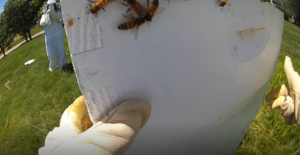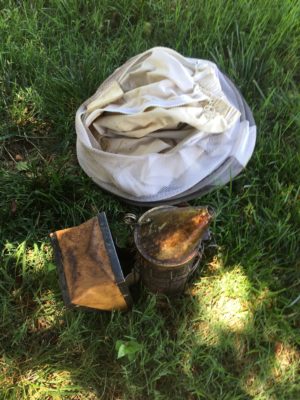There are so many lessons to be learned from bees and visiting a beehive makes those lessons come to life in a way that reading can’t match. People have differing reasons for wanting to take that on too. I love that Kamal Bell and I could talk about the beehives at Sankofa Farms.
As I mentioned in that episode, I have always been afraid, even terrified of bees. Growing up, I always heard that if dad got stung, we had to take him to the hospital, so when I got stung by honey bees and started swelling up like crazy, I was understandably scared. No way would I ever dream of visiting a beehive on purpose!
I let that fear impact all kinds of things which a lot of people never realized. Slowly I have learned my allergy to the stings doesn’t mean I can never be near a bee. And I don’t have to let them chase me indoors either. So a few years ago I visited beehives for the first time.
Why I Wanted to Visit a Beehive
Some folks would ask why I would bother challenging myself so hard. I’ve lived this long afraid of bees and I do have a very real health concern with their stings. But understanding the environment is something I’ve always wanted to learn more about and these bees are so important to us…. I’d hate to do without blueberries, almonds, and a third of the other foods I eat that depend on pollination!
Here are a few things I learned that I found really interesting:
There are 4,000 different kinds of bees in the US. – Honey bees are the only ones that are community builders. That makes them a great resource for pollinating lots of food crops. Without honey bees our dinner plates and grocery stores would look dramatically different.
- Honey bees travel up to two miles from their hive to find nectar so they can convert that into honey and pollen which provides food for the hive and sweeteners for us!
- The distance will really make you think…. to produce 150 pounds of honey, bees travel the distance that’s equivalent to 13 roundtrips to the moon.
What to Wear When Visiting a Beehive
The gear for beekeeping is way heavier and less airy than it looks, and many beekeepers forego some of it to make moving around easier and cooler. But since it is highly effective in keeping me safe, when I set my sights on visiting a beehive, I wore all of it!
The canvas coveralls are thick canvas since a bee could potentially sting it and the thicker fabric keeps the stinger from reaching my skin.
- That hat/hood/visor thing feels SO STRANGE. It zipped to the coveralls and then there were velcro covers for those zipper connections. I was sealed up!
- Thick leather gloves …. really thick and they went up to my elbow. Again…. very safe.
- A small smoker to calm the bees down — very cool!
- I wore my fauxpro to get some closeups. Now that I know the coveralls, etc I will position it differently next time.
- Zippers and elastic on the pants legs made sure I was covered down there too. Probably should have worn shorts under it with the heat, but I thought my bee leggings send a powerful signal!
- Another colleague recommended I wear my Chuck Taylor’s, I wanted to wear leather (thinking safety) so I did both!
Learning to Live Alongside Bees
Honey bees go out of the hive to explore, looking for pollen. That’s their sole mission. If you are like me & don’t mix well with them, here are some tips:
- In general, bees are focused on the job at hand, only sting when threatened – very different from wasps.
- When people swat at bees, the bee feels threatened. Their only defense mechanism is stinging you.
- When I am going to be outside, I don’t wear fragrances. Bees are attracted to them, want to see what’s up, whether pollen & nectar are there and well, that freaks me out and I’m likely to swat at them. Which… is not a good idea. (See above LOL).
- If bees seem to be buzzing around me, they are looking for nectar. They do that more in sunlight so if shade is nearby, I can wander over there and they usually leave me alone.
- Plant pollinator plants in areas of the yard where people don’t want to hang out, that gives bees a place to go, so they are less likely to explore around me. Sunny corner of the yard works fine.
A Video of My Bee Adventure
I was hosting a Facebook live session for a project with work, so I was doing video for that and I had other cameras. The video is bumpy. You’ll see a combination of video here — my mobile, my faux pro and a teammate’s camera all!
Hope some of you take time to watch and I’d love to hear your thoughts!


 There are 4,000 different kinds of bees in the US. – Honey bees are the only ones that are community builders. That makes them a great resource for pollinating lots of food crops. Without honey bees our dinner plates and grocery stores would look dramatically different.
There are 4,000 different kinds of bees in the US. – Honey bees are the only ones that are community builders. That makes them a great resource for pollinating lots of food crops. Without honey bees our dinner plates and grocery stores would look dramatically different.

